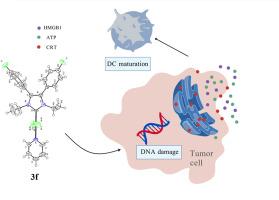当前位置:
X-MOL 学术
›
Eur. J. Med. Chem.
›
论文详情
Our official English website, www.x-mol.net, welcomes your
feedback! (Note: you will need to create a separate account there.)
More than just DNA damage: Pt(ΙΙ)-NHC complexes derived from 4,5-diarylimidazoles augment immunogenic cell death
European Journal of Medicinal Chemistry ( IF 6.0 ) Pub Date : 2024-11-12 , DOI: 10.1016/j.ejmech.2024.117014 Lu Tang, Xingyu Chang, Jing Shi, Zhenfan Wen, Chunyang Bi, Wukun Liu
European Journal of Medicinal Chemistry ( IF 6.0 ) Pub Date : 2024-11-12 , DOI: 10.1016/j.ejmech.2024.117014 Lu Tang, Xingyu Chang, Jing Shi, Zhenfan Wen, Chunyang Bi, Wukun Liu

|
Platinum-based drugs are a mainstay in chemotherapy, with traditional forms exerting their work directly on DNA. In recent years, it has been observed that platinum complexes had the potential to induce immunogenic cell death (ICD) and effectively trigger antitumor immune responses. Herein, to obtain novel platinum complexes with chemo-immunological properties, a series of Pt(ΙΙ)-N-heterocyclic carbene (Pt(ΙΙ)-NHC) complexes derived from 4,5-diarylimidazoles were synthesized. Among them, the dominant complex 3f was proved to exhibit better anti-liver cancer capacity compared to cisplatin and oxaliplatin. Complex 3f showed the ability to cause DNA damage by binding to DNA. In addition, it triggered intracellular reactive oxygen species (ROS) generation, affected the function of mitochondria, and blocked cells in G0/G1 phase, ultimately induced apoptosis in liver cancer cells. Furthermore, complex 3f activated endoplasmic reticulum stress (ERS) which promoted the release of damage-associated molecular patterns (DAMPs), induced ICD and dendritic cells (DCs) maturation. Interestingly, complex 3f also upregulated PD-L1, consequently converted "cold tumors" into "hot tumors". Overall, complex 3f had the potential to be regarded as a promising chemoimmunotherapy for the treatment of liver cancer.
中文翻译:

不仅仅是 DNA 损伤:源自 4,5-二芳基咪唑的 Pt(ΙΙ)-NHC 复合物可增强免疫原性细胞死亡
铂类药物是化疗的主要药物,传统形式直接作用于 DNA。近年来,据观察,铂复合物具有诱导免疫原性细胞死亡 (ICD) 并有效触发抗肿瘤免疫反应的潜力。在此,为了获得具有化学免疫学特性的新型铂配合物,合成了一系列源自 4,5-二芳基咪唑的 Pt(ΙΙ)-N-杂环卡宾 (Pt(ΙΙ)-NHC) 配合物。其中,显性复合物 3f 被证明与顺铂和奥沙利铂相比表现出更好的抗肝癌能力。复合物 3f 显示出通过与 DNA 结合导致 DNA 损伤的能力。此外,它触发细胞内活性氧 (ROS) 的产生,影响线粒体的功能,阻断 G0/G1 期细胞,最终诱导肝癌细胞凋亡。此外,复合 3f 激活内质网应激 (ERS),促进损伤相关分子模式 (DAMP) 的释放,诱导 ICD 和树突状细胞 (DC) 成熟。有趣的是,复合物 3f 也上调了 PD-L1,从而将“冷肿瘤”转化为“热肿瘤”。总体而言,复合物 3f 有可能被视为一种有前途的化疗免疫疗法,用于治疗肝癌。
更新日期:2024-11-12
中文翻译:

不仅仅是 DNA 损伤:源自 4,5-二芳基咪唑的 Pt(ΙΙ)-NHC 复合物可增强免疫原性细胞死亡
铂类药物是化疗的主要药物,传统形式直接作用于 DNA。近年来,据观察,铂复合物具有诱导免疫原性细胞死亡 (ICD) 并有效触发抗肿瘤免疫反应的潜力。在此,为了获得具有化学免疫学特性的新型铂配合物,合成了一系列源自 4,5-二芳基咪唑的 Pt(ΙΙ)-N-杂环卡宾 (Pt(ΙΙ)-NHC) 配合物。其中,显性复合物 3f 被证明与顺铂和奥沙利铂相比表现出更好的抗肝癌能力。复合物 3f 显示出通过与 DNA 结合导致 DNA 损伤的能力。此外,它触发细胞内活性氧 (ROS) 的产生,影响线粒体的功能,阻断 G0/G1 期细胞,最终诱导肝癌细胞凋亡。此外,复合 3f 激活内质网应激 (ERS),促进损伤相关分子模式 (DAMP) 的释放,诱导 ICD 和树突状细胞 (DC) 成熟。有趣的是,复合物 3f 也上调了 PD-L1,从而将“冷肿瘤”转化为“热肿瘤”。总体而言,复合物 3f 有可能被视为一种有前途的化疗免疫疗法,用于治疗肝癌。


















































 京公网安备 11010802027423号
京公网安备 11010802027423号